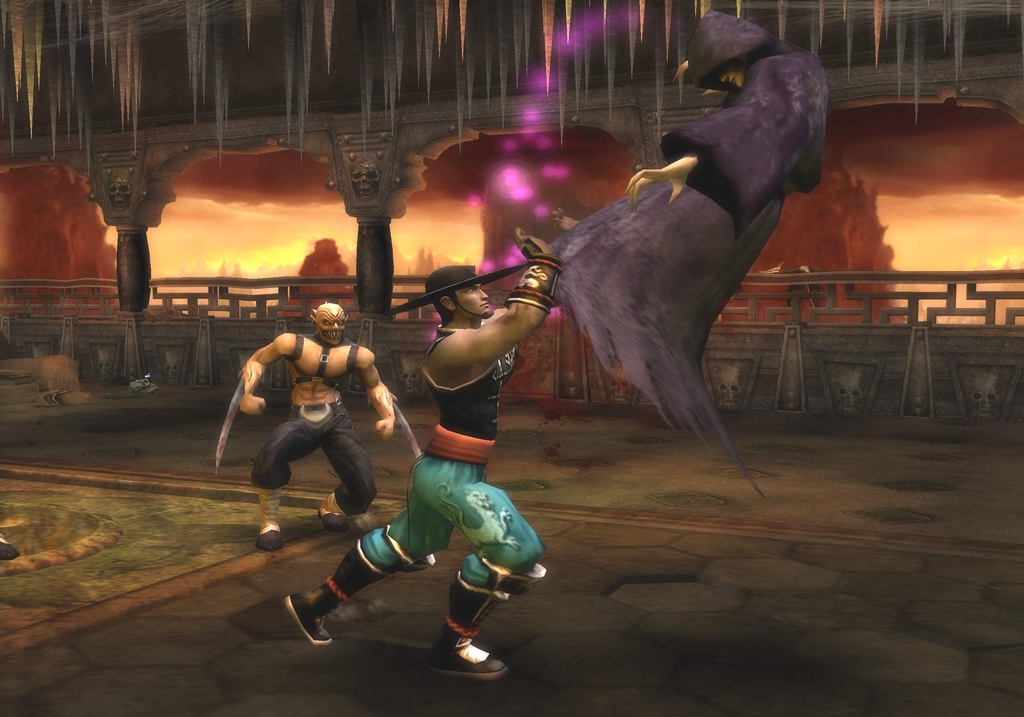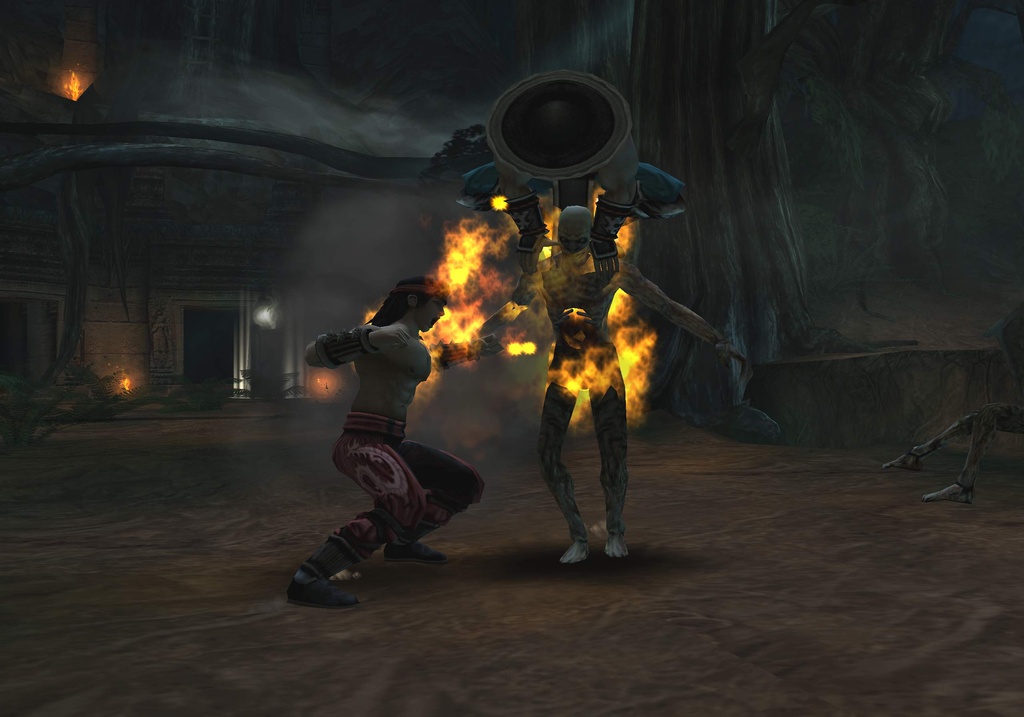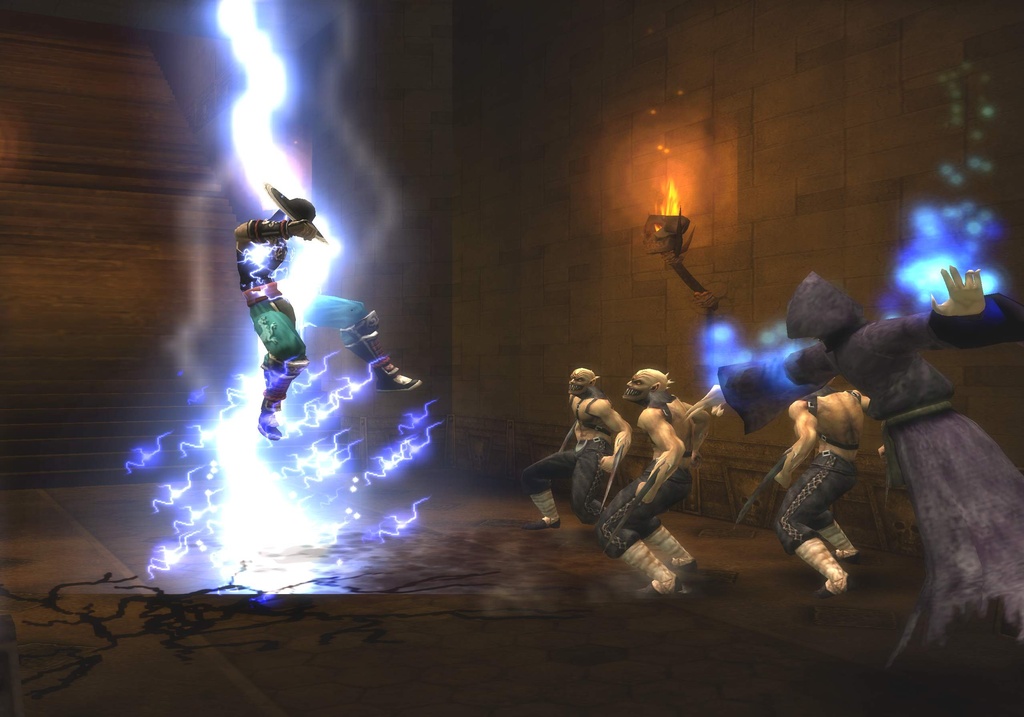When you think about the efforts Midway has made to turn the Mortal Kombat franchise into something other than that of a pure fighter, try not to lump Shaolin Monks in with the publisher's previous attempts. It would be simply unfair to compare it to the likes of the rather flawed Mythologies: Sub-Zero, and it would be an out-and-out travesty to lump it in with something like the completely awful Mortal Kombat Special Forces. Shaolin Monks does something that no other non-fighting-based MK game has managed to pull off: It provides quality fan service to dedicated Kombat aficionados everywhere. Apart from actually putting together a completely decent gameplay engine, Shaolin Monks is so ridiculously chock-full of hidden goodies and subtle wink-and-nod-style in-jokes that anybody who professes to have a degree in MK will be hard-pressed not to come away entertained. With that said, Shaolin Monks will be almost exclusively interesting to MK fans, because if you were to take away the license you'd be left with a fairly unassuming and short brawler with a few serious flaws. But if you do profess to be a lover of all things classic Kombat, then Shaolin Monks is worth checking out.
Shaolin Monks takes place during what some would call the ideal period of Mortal Kombat's mythology. The game picks up right at the end of the original Mortal Kombat tournament, with Shang Tsung recently defeated and trying to make his escape. All the main characters from the first game are present during this opening sequence (including the elusive Reptile), and things start shifting into MKII territory when Kung Lao, Liu Kang's fellow Shaolin brother, arrives on the scene. Things start getting hairy after Shang Tsung's escape, when the island on which the original tournament took place begins falling apart. The "kombatants" start to flee the island, but Liu Kang and Kung Lao fall into Goro's underground lair during a tremor. This is where the gameplay initially picks up.
There are two basic ways to play Shaolin Monks: in single-player or cooperatively. Either option presents you with two initially unlocked characters in Liu Kang and Kung Lao (and a couple of not-so-subtly placed, shadowy "ninjalike" characters that hover in the background--unlockables, anybody?) Pick your poison here, because you'll never get to switch characters once you start playing, and you'll never have the option of turning a single-player game into a cooperative one, or vice versa. The two modes are entirely exclusive from each other, which is extremely unfortunate, since a good bit of the game's unlockables (and playability, for that matter) comes from the cooperative mode. Unless you've got someone handcuffed to you that you can play with for extended periods of time, you might find yourself a bit distressed at how much of the secret content is given to the cooperative mode. But if you do have someone else to play with, you'll have the ideal experience the game has to offer.
Functionally, Shaolin Monks is a fairly simple beat-'em-up that turns the many classic MK moves into one-to-two-button presses. Most of the basic attacks and combos can be strung together via simple button mashing, but there are several moves and maneuvers that require specific timing and button combinations to succeed. Most of these aren't the typical Liu Kang and Kung Lao special moves, as you need only hold down the right trigger button and press one of the main attack buttons to do any of these, like Kang's fireballs or Lao's tornado hat slice. Fatalities are simplified too. One need only build up a meter to its peak point and then hit a single button to pull off a fatality stun move. Once that's done, a series of button presses will appear onscreen. And if you hit the right combo quickly enough, you'll pull off one of those ever-famous fatal blows. If you continue building up the meter, you can pull off two higher tiers of fatalities (called multalities--for killing multiple foes--and brutalities, respectively). Some of the kills you can pull off on the boss enemies are pretty awesome, but many of the simple fatalities you do to grunt enemies are kind of dumb.
Liu Kang and Kung Lao both have their own unique maneuvers and combos, and both can be upgraded via experience points. You earn experience for offing foes during the course of the game, but only if you do so yourself. If you use any of the numerous environmental hazards, you get exactly squat. Anyway, experience points can be used to purchase new special moves and combos, and there are a pretty good number of them available throughout the course of the game. There are even a few team moves you can pull off when playing cooperatively. Still, even with the upgrades and combos, the basic combat is a pretty simplistic affair. Apart from the tougher boss fights, all you really need to do is just button-mash your way through enemies, periodically stopping to block or uppercut a bad guy into a puzzle-based trap from time to time. That doesn't make the fighting portion of the game not fun, mind you, it's just not exactly an overly deep fighting system. But then, for what the game is trying to accomplish, it probably doesn't really need to be, either.

What is Shaolin Monks trying to accomplish, anyway? Its sole purpose in this world seems to be to cull together every crazy gimmick, secret, and rumor ever concocted about the first couple of Mortal Kombat games so it can cram all of them into a beat-'em-up. In that regard, mission accomplished. Every aspect of this game oozes Mortal Kombat nostalgia. There's a fantastic array of characters featured in the game, for one. Every character from MKs one and two are on hand, as well as a few choice characters from three and four. Though some of these characters, like Johnny Cage and Sub-Zero, periodically act as artificial-intelligence-controlled allies, many of these characters serve as boss fights and secrets. Even outside of characters, there are so many insanely obscure references to MK lore all over this game that any serious fan will probably go nuts trying to find them all. Some of these references are pretty blunt. Remember how everybody thought you could uppercut opponents onto those hooks in the dead pool stage in MKII? Or how everybody thought you could knock them into the living trees in the living forest stage? Well, not only can you do those things in this game, but also they're required puzzles! Most references are more opaque than this, however, so it'll take you quite a bit of painstaking effort to find them all.
But you will need to play cooperatively to find a lot of them. Again, Shaolin Monks was clearly designed with co-op play as the focal point, and as such, lots of hidden items, characters, and areas can only be accessed via the "ko-op" mode, as it's titled. Fortunately, this is the kind of game MK fans will want to play at least a couple of times. You can easily play through once in single-player and once cooperatively, and you'll enjoy it for entirely different reasons on each play-through.

Unfortunately, at times you'll feel like you're rehashing some of the same stuff over and over again--and we're not talking about on multiple plays, either. The underlying level design in Shaolin Monks relies heavily on a lot of backtracking through the same worlds to get to different places. A certain amount of it makes sense, since so many of the hidden items and areas often can't be accessed until you gain new abilities, but even when you're just trying to go from mission to mission, there's an awful lot of running back and forth through the same hub worlds and stages. Then again, considering how short the game is, it's not altogether surprising that the developer might try to pad the length a bit via something like this. The game is also all over the place in terms of difficulty. On the default difficulty, most of it is pretty easy--almost too easy--in certain situations. Some of the boss fights are pathetically easy to win, including a particularly anticlimactic fight against Goro. Others, like the 1-2-3 punch of Shang Tsung, Kintaro, and Shao Kahn (all in a row, with no life bar help for you), are painfully cheap. Fortunately, there are times when the game gets the balance right, too. The fight against Scorpion, in particular, is really good. It's just a shame the game isn't more consistent overall. As for other content beyond the story mode, there is a fairly rudimentary versus fighting mode available, but it can't be called anything better than a meaningless distraction, and you only get a handful of fighters to use in the mode.
As with the game's length, Shaolin Monks' plot is stretched thin. Granted, trying to turn the storyline of a fighting game into a multihoured action plot isn't always the easiest thing in the world, even when you're working with the relatively deep Mortal Kombat mythos. Just look at the Mortal Kombat movies, for instance. The first one managed decently enough for a two-hour film, but as for the sequel... Well, the less said about that, the better. Shaolin Monks' story starts off reasonably well, but over time it degenerates into a fairly incomprehensible mess, with all sorts of pseudo-betrayals, overwrought plot twists, and a few halfhearted introductions of random characters for seemingly no reason other than because the developer had to find a way to squeeze them in. Jax, for instance, makes his main story appearance way late in the game, shows up for about a minute, and then disappears. These strained uses of the MK characters are more aberration than the norm, though, so you'll see plenty of main characters, like Raiden, Johnny Cage, Sub-Zero, Scorpion, Kitana, and the like, used reasonably well throughout the game. And while the story doesn't make an awful lot of sense, overall it's about on par with any of the other Mortal Kombat storylines.
On the technical side of things, Shaolin Monks isn't exactly pushing any boundaries graphically. Close inspection of the character models reveals some fairly low-resolution faces and costumes, and the animations are occasionally choppy and inconsistent. But again, technical prowess is not really what makes Shaolin Monks good. Instead, it's aesthetics and attention to the details that are based on source material. On that level, Shaolin Monks does a fine job of re-creating the atmosphere of early Mortal Kombat. In fact, at times it's downright obsessive. Practically every fighting arena from MKII has been re-created here as some level or another. You'll find yourself wandering through the living forest, uppercutting bad guys into the pit, and navigating the pitfalls of the barren wasteland. The character designs are like a hybrid between classic and modern MK, and they're the right kind of hybrid, too, updating the looks beyond the old days but without straying too far from the original concepts. Unfortunately, the designs for the characters that aren't directly from an MK game aren't nearly as good. Apart from a couple of cool-looking masked soldiers and the evil shadow priests that just float around in the background of a couple of MKII stages, most enemies rarely transcend awkward corpses, generic-looking troll creatures, and a lot of faceless agents of the outworld. Granted, they all die excellently, and cutting and beating them up can be quite satisfying. You'd just hope for a bit more in the way of creativity on the enemy front.

The audio in Shaolin Monks is on a similar keel. Technically, very little leaps out. The voice acting is exceptionally ham-fisted, and in some cases, it's absolutely awful. But conversely, most of the music and many of the sound effects seem to have been lifted directly out of Mortal Kombat II. Liu Kang's ridiculous martial arts shrieks are all fully intact, and you'll even get all the little, subtle sounds too, like the insidious-sounding announcer who says "Excellent" and "Fatality" at the appropriate times. In addition, Dan "Toasty" Forden's voice returns once again to utter the famous line at all the right times. It's totally bananas that the developer would dig deep enough into the vault to actually trot out so many of these old sound effects and musical tracks, and even many of the newer-sounding effects and tracks still sound like the older stuff. From a purely atmospheric perspective, this is awesome.
When it comes down to it, if you're a Mortal Kombat fan, you'll like Shaolin Monks. If you aren't, you won't. The core action of the game will be enjoyable to any beat-'em-up fan, but what makes Shaolin Monks specifically appealing isn't its brawling. Instead, it's the game's unrelenting desire to cater to classic Kombat fans. Average players aren't likely to want to seek out all the crazy, hidden missions you have to accomplish to unlock the included arcade port of Mortal Kombat II, for instance, but fans are likely to squeal with delight at the thought of being able to unlock their favorite arcade fighter. And that's pretty much how it is with the entirety of the game. It's fan service, pure and simple, and as such, the vast bulk of the content is only going to be appealing to those with a penchant for fatalities and toasty guy. So if you played and loved the classic Mortal Kombat fighters, Shaolin Monks is a game well worth checking out. For anybody else, Shaolin Monks might make for a solid rental; but ultimately, this one's probably best left to the fans.




